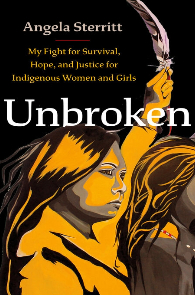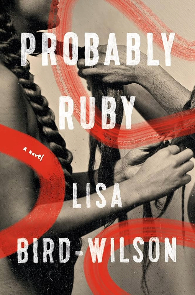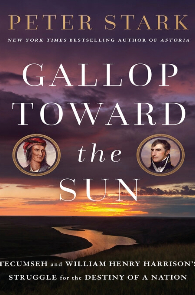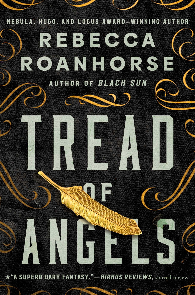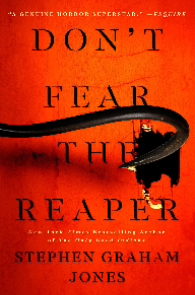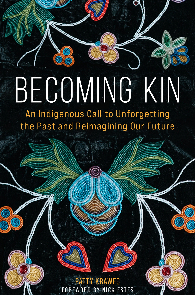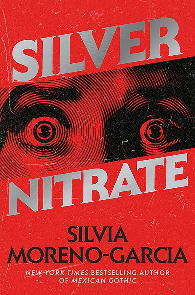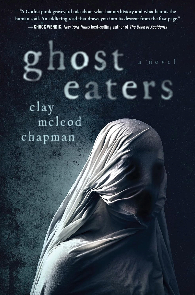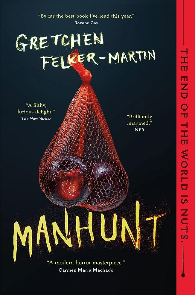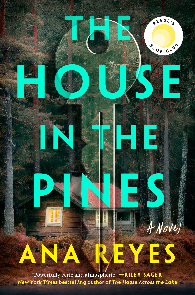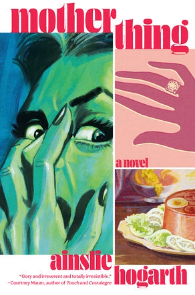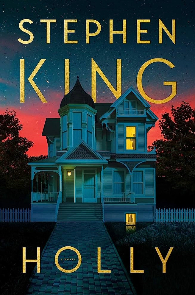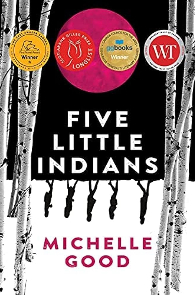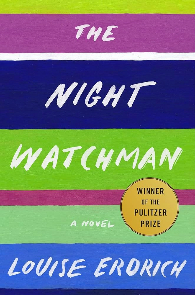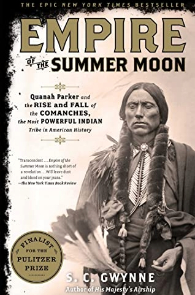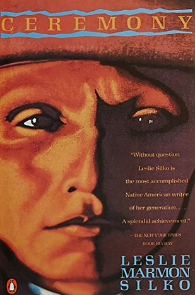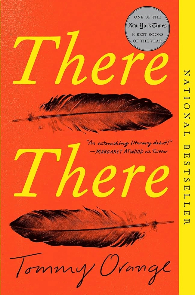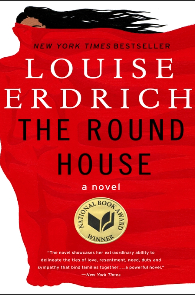Uncategorized
OHC Staff Reflects on 2023
The Oral History Center has been as busy as ever this year, publishing hundreds of hours’ worth of interviews online. On top of making this wide range of voices available to the public, my colleagues have also used these collections of The Bancroft Library to interpret, frame and share new stories about our past. In November, the Japanese American Intergenerational Narratives project was launched, featuring interviews with the descendants of the incarceration camps during World War II. Not only are the transcripts online, but there is also a podcast and a deeply moving work of graphic illustrations that draw meaning from the interviews. In October, Todd Holmes and Roger Eardley-Pryor designed, wrote, and launched a new museum exhibit, Voices for the Environment: A Century of Bay Area Activism at the Bancroft Library Gallery, which runs through November 2024. There is an accompanying digital exhibit, which will feature podcasts, mini-documentaries, and a curriculum guide for students and teachers that will live on long after the gallery exhibit closes.
Center staff showed great leadership in the field of oral history. There is always lots to say about our oral history education programs, but what was new this year was OHC participation in a pilot historical methods course for undergraduate majors of UC Berkeley’s history program. Oral historian Shanna Farrell took a seat this year on the council of the Oral History Association, and Amanda Tewes and Roger Eardley-Pryor also led panels and gave papers at the OHA annual meeting. Todd Holmes, together with our Advanced Institute alum Emi Kuboyama, won the Autry Prize from the Western History Association for their documentary on the redress of the incarceration of Japanese Americans during World War II.
Communications and editorial lead Jill Schlessinger created, oversaw, and updated our editorial process. On the back end of our production, David Dunham led the team that transferred and preserved almost two thousand hours of audio-video that was trapped on defunct recording formats. Of course, we couldn’t have done this work without the help we get from student employees in production, preservation, and communications. Finally, following a competitive national search, I would like to celebrate the arrival of the new historian of science, technology, and medicine, Liz Semler.
I want to thank every member of the OHC staff for a great year! From all of us, we wish you all a peaceful and magical holiday and a wonderful 2024!
–OHC Director Paul Burnett
OHC Staff Reflections
I am grateful to have celebrated my 21st year with the Oral History Center. It is a privilege to support the efforts of our interviewers in producing the array of oral histories produced this year. I relish the opportunity to work with student workers, undergraduate research apprenticeship program [URAP] participants, and librarian interns. Students are integral to our production and preservation processes, ensuring that our transcripts, audio, and video are accessible and preserved. They also bring new perspectives and insights into our oral histories. It’s a cliche to say win-win, but our student workers and interns consistently share how participating with the OHC enriches their academic, intellectual, professional, and human interests. We could not do a fraction of the work we do without them. Special thanks this year to the following students and interns that contributed in countless ways to the OHC: Max Afifi; Sadie Baldwin; Peter Beshay; Hue Bui; Mina Choi; Georgia Cutter; Jason de Haaff; Nikki Do; Ava Escobedo; Leah Freeman; Samantha Goodson; Meiya Gujjalu; Anthony Lin; Lina Matine; Solomon Nichols; Guisselle Salazar; Mela Seyoum; Joe Sison; Manyi Tang; Kate Trout; Erin Vinson; and Cathy Zhang.
–David Dunham
My fifth year at OHC was the busiest yet! I’m especially grateful for exceptional and collaborative colleagues at OHC. This past year, we curated our first oral-history-focused gallery exhibit with videos and a podcast; we promoted our innovative Japanese American Intergenerational Narratives project, including graphic art and a superlative podcast; and we continued conducting and publishing outstanding oral history interviews. I’m also grateful that our new colleague, Liz, joined the OHC team. I hope you and yours celebrate all that’s good at the end of this year, and that next year is even better.
–Roger Eardley-Pryor
What a year 2023 has been! While I’ve had the privilege of working on several projects this past year, I’m very proud of working with Roger Eardley-Pryor and Amanda Tewes on the Japanese American Intergenerational Narratives project, which launched in November. We interviewed 23 survivors and descendants of WWII-era site of Japanese American incarceration, and produced a podcast and commissioned an artist to make graphic illustrations based on these oral histories. It’s been an extremely meaningful project to be a part of, and I’m grateful for the collaborative efforts of my colleagues to bring it to fruition.
–Shanna Farrell
Looking back on the year of 2023, I am struck by the power of collaboration. This year the Oral History Center curated the multimedia exhibit, Voices for the Environment: A Century of Bay Area Activism, at The Bancroft Gallery, a collaborative effort that was beyond rewarding. I am extremely grateful for the opportunity to do this work and collaborate with an amazing cast of colleagues.
–Todd Holmes
I look forward every year to this opportunity to acknowledge the talented team of student editors that make the pace of our work possible. They do the work of professional editors, create abstracts for oral histories with missing metadata, write articles about our narrators and projects, and provide invaluable suggestions in our department’s quest for continuous improvement of our workflow and processes. We said farewell to some long-term employees who recently graduated: Mollie Appel-Turner, William Cooke, Adam Hagen, Serena Ingalls, and Shannon White; I’d like to say thank you to our ongoing editor, Timothy Yue; and welcome two new staff, Nikhil Jagota and Lauren von Aspen. My favorite memory from 2023 was learning about how the experience of working with oral history has had a profound impact on how our student employees see things. I hope you will enjoy reading about their reflections as much as I did in this article, Connection, Insight, Inspiration, Truth: Berkeley undergraduates reflect on oral history.
–Jill Schlessinger
This past year has been a wild ride! I said goodbye to multi-year projects, moved across the country, and started a position at the Oral History Center in October. Although it’s only been a few months, I’ve already learned much in my new role, including technical details like how to use video recording equipment and more broadly about UC Berkeley and the surrounding area. As with any big change, sometimes I feel overwhelmed with the new-ness of it all. But change brings opportunity! I’m grateful for the chance to forge a new path as an interviewer and historian here at the Oral History Center and am excited to discover what the upcoming year holds.
–Liz Semler
In November 2023, I was honored to be a part of a great team (along with Roger Eardley-Pryor and Shanna Farrell) that launched the Japanese American Intergenerational Narratives Oral History Project, featuring 100 hours of oral history interviews with 23 Japanese American narrators who are survivors and descendants of two World War II-era sites of incarceration: Manzanar in California and Topaz in Utah. This public launch highlighted the release of most of the 23 oral history interviews, a four-part podcast series based on these original interviews, and graphic art inspired by the stories and themes from the interviews. It has truly been a meaningful experience to be a part of such important work about intergenerational memory and healing. Many thanks to the National Park Service’s Japanese American Confinement Sites Grant for funding this phase of the project!
–Amanda Tewes
The Oral History Center Presents The Berkeley Remix Season 8: “‘From Generation to Generation’: The Legacy of Japanese American Incarceration”
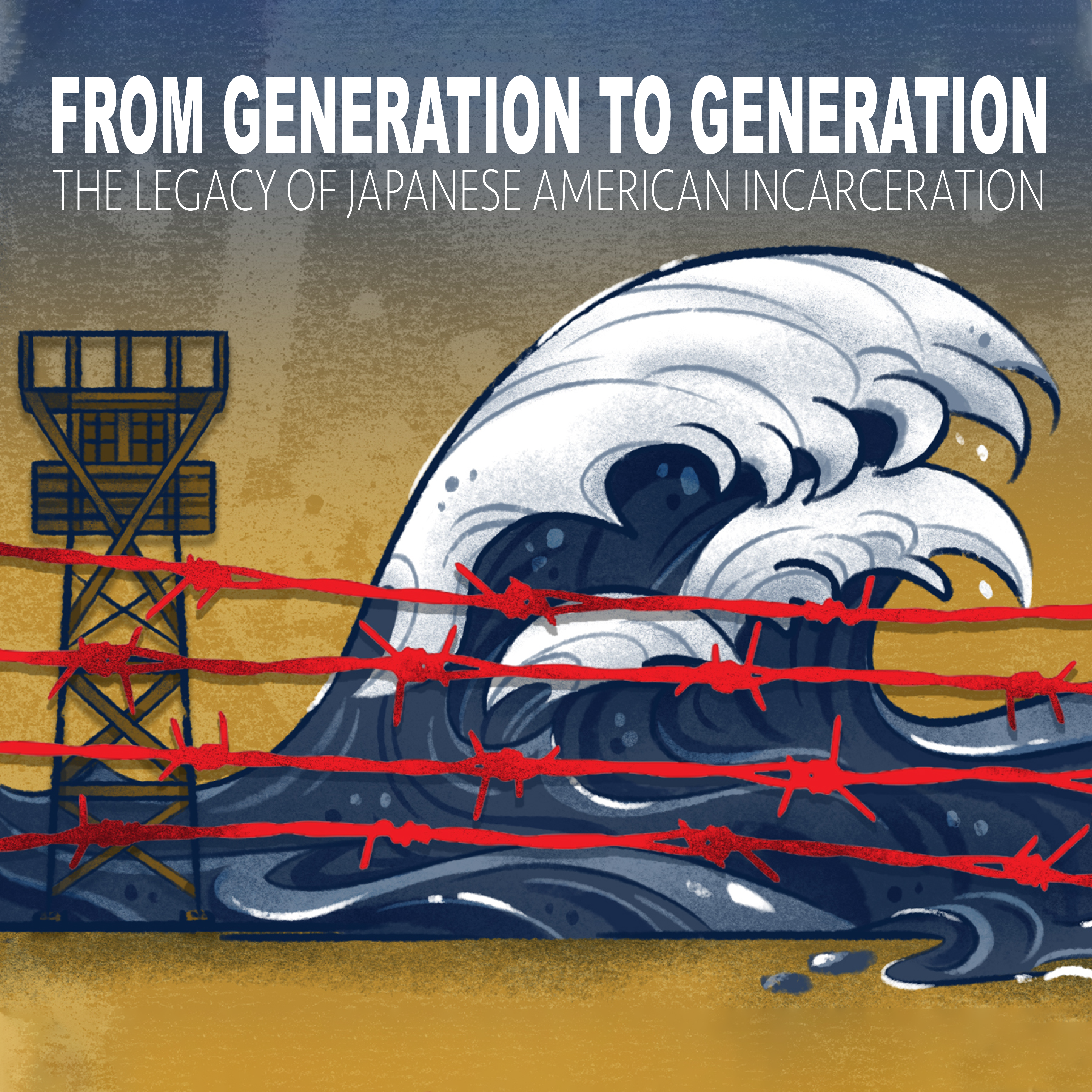
Just a couple of months after the United States entered World War II, President Franklin D. Roosevelt signed Executive Order 9066 on February 19, 1942. This order authorized the government to forcibly remove more than 120,000 Japanese American civilians—even American-born citizens—from their homes on the West Coast, and put them into incarceration camps shrouded in barbed wire and patrolled by armed guards for the duration of the war. This imprisonment uprooted families, disrupted businesses, and dispersed communities—impacting generations of Japanese Americans.
In season 8 of The Berkeley Remix, a podcast of the Oral History Center at UC Berkeley, we are highlighting interviews from the Japanese American Intergenerational Narratives Oral History Project. The OHC team interviewed twenty-three survivors and descendants of two World War II-era sites of incarceration: Manzanar in California and Topaz in Utah. This four-part series includes clips from these interviews, which were recorded remotely via Zoom. Using healing as a throughline, these life history interviews explore identity, community, creative expression, and the stories family members passed down about how incarceration shaped their lives.
This season features interview clips from the Japanese American Intergenerational Narratives Oral History Project.
Produced by Rose Khor, Roger Eardley-Pryor, Shanna Farrell, and Amanda Tewes. Narration by Devin Katayama. Artwork by Emily Ehlen. A special thanks to the National Park Service’s Japanese American Confinement Sites Grant for funding this project.
The views and conclusions contained in this document are those of the authors and should not be interpreted as representing the opinions or policies of the U.S. Government. Mention of trade names or commercial products does not constitute their endorsement by the U.S. Government.
Episode 1: “‘It’s Happening Now’: Japanese American Activism.” In this episode, we explore activism and civic engagement within the Japanese American community. The World War II-era incarceration of Japanese Americans inspired survivors and descendants to build diverse coalitions and become engaged in social justice issues ranging from anti-Vietnam War activism to supporting Muslim Americans after 9/11 to protests against the separation of families at the US-Mexico border. Many Japanese Americans also participated in the redress movement, during which time many individuals broke their silence about incarceration, and empowered the community to speak out against other injustices.
This episode features interviews from the Oral History Center’s Japanese American Intergenerational Narratives Oral History Project, and includes clips from: Bruce Embrey, Hans Goto, Jean Hibino, Roy Hirabayashi, Susan Kitazawa, Kimi Maru, Margret Mukai, Ruth Sasaki, Nancy Ukai, and Rev. Michael Yoshii. Additional archival audio from Tsuru for Solidarity and the National Archives. The transcript from Sue Kunitomi Embrey’s testimony comes from the Los Angeles hearings from the Commission on Wartime Relocation and Internment of Civilians. To learn more about these interviews, visit the Oral History Center’s website.
Episode 2: “‘A Place Like This’: The Memory of Incarceration.” In this episode, we explore the history, legacy, and contested memory of Japanese American incarceration during World War II. Incarceration represented a loss of livelihoods, property, and freedom, as well as a disruption—cultural and geographic—in the Japanese American community that continued long after World War II. While some descendants heard family stories about incarceration, others encountered only silence about these past traumas. This silence was reinforced by a society and education system which denied that incarceration occurred or used euphemisms to describe what Japanese Americans experienced during World War II. Over the years, Japanese Americans have worked to reclaim the narrative of this past and engage with the nuances of terminology in order to tell their own stories about the personal and community impacts of incarceration.
This episode features interviews from the Oral History Center’s Japanese American Intergenerational Narratives Oral History Project, and includes clips from: Miko Charbonneau, Bruce Embrey, Hans Goto, Patrick Hayashi, Jean Hibino, Mitchell Higa, Carolyn Iyoya Irving, Susan Kitazawa, Ron Kuramoto, Kimi Maru, Lori Matsumura, Alan Miyatake, Jennifer Mariko Neuwalder, Ruth Sasaki, Masako Takahashi, Peggy Takahashi, Nancy Ukai, and Rev. Michael Yoshii. Additional archival audio from the US Office of War Information and the Internet Archive. To learn more about these interviews, visit the Oral History Center’s website.
Episode 3: “‘Between Worlds’: Japanese American Identity and Belonging.” In this episode, we explore identity and belonging in the Japanese American community. For many Japanese Americans, identity is not only personal, it’s a reclamation of a community that was damaged during World War II. The scars of the past have left many descendants of incarceration feeling like they don’t wholly belong in one world. Descendants have navigated identity and belonging by participating in Japanese American community events and supporting community spaces, traveling to Japan to connect with their heritage, as well as cooking and sharing Japanese food. However, embracing Japanese and Japanese American culture can highlight for descendants their mixed identities, leaving them feeling even more like they have a foot in multiple worlds.
This episode features interviews from the Oral History Center’s Japanese American Intergenerational Narratives Oral History Project, and includes clips from: Miko Charbonneau, Hans Goto, Jean Hibino, Roy Hirabayashi, Carolyn Iyoya Irving, Susan Kitazawa, Kimi Maru, Lori Matsumura, Alan Miyatake, Jennifer Mariko Neuwalder, Ruth Sasaki, Steven Shigeto Sindlinger, Masako Takahashi, Peggy Takahashi, Nancy Ukai, Hanako Wakatsuki-Chong, and Rev. Michael Yoshii. To learn more about these interviews, visit the Oral History Center’s website.
Episode 4: “‘Origami as Metaphor’: Creative Expression, Memorialization, and Healing.” In this episode, we explore creative expression, healing, and the memorialization of Japanese American incarceration. It is clear that stories about World War II incarceration matter. Some descendants embrace art and public memorialization about incarceration history as not only means of personal creative expression and honoring the experiences of their ancestors, but also as avenues to work through the intergenerational impact of this incarceration. Stories shared through art and public memorialization help people both inside and outside of the Japanese American community learn about the past so they have the tools to confront the present. Others seek healing from this collective trauma by going on pilgrimage to the sites of incarceration themselves, reclaiming the narrative of these places.
This episode features interviews from the Oral History Center’s Japanese American Intergenerational Narratives Oral History Project, and includes interviews from: Miko Charbonneau, Bruce Embrey, Hans Goto, Patrick Hayashi, Jean Hibino, Mitchell Higa, Roy Hirabayashi, Carolyn Iyoya Irving, Susan Kitazawa, Ron Kuramoto, Kimi Maru, Lori Matsumura, Jennifer Mariko Neuwalder, Ruth Sasaki, Masako Takahashi, Nancy Ukai, Hanako Wakatsuki-Chong, and Rev. Michael Yoshii. Additional audio of taiko drums from Roy Hirabayashi. To learn more about these interviews, visit the Oral History Center’s website.
ABOUT THE ORAL HISTORY CENTER
The Oral History Center of The Bancroft Library preserves voices of people from all walks of life, with varying political perspectives, national origins, and ethnic backgrounds. We are committed to open access and our oral histories and interpretive materials are available online at no cost to scholars and the public. You can find our oral histories from the search feature on our home page. Search by name, keyword, and several other criteria. Sign up for our monthly newsletter featuring think pieces, new releases, podcasts, Q&As, and everything oral history. Access the most recent articles from our home page or go straight to our blog home.
Please consider making a tax-deductible donation to the Oral History Center if you would like to see more work like this conducted and made freely available online. The Oral History Center is a predominantly self-funded research unit of The Bancroft Library. As such, we must raise the funds to cover the cost of all the work we do, including each oral history. You can give online, or contact us at ohc@berkeley.edu for more information about our funding needs for present and future projects.
Q&A with Artist Emily Ehlen on Illustrating the OHC’s Japanese American Intergenerational Narratives Oral History Project

For the first time, the Oral History Center, or OHC, partnered with an artist named Emily Ehlen, who created ten graphic narrative illustrations based upon stories and themes recorded in the OHC’s Japanese American Intergenerational Narratives Oral History Project, or JAIN project. The JAIN project documents and disseminates the ways in which intergenerational trauma and healing occurred after the United States government’s mass incarceration of Japanese Americans during World War II.

The OHC’s JAIN project documents and disseminates the ways in which intergenerational trauma and healing occurred after the United States government’s mass incarceration of Japanese Americans during World War II. The OHC team interviewed twenty-three Japanese American survivors and descendants of the World War II incarceration to investigate the impacts of healing and trauma, how this informs collective memory, and how these narratives change across generations. Initial interviews in the JAIN project focused on the Manzanar and Topaz prison camps in California and Utah, respectively. The JAIN project began at the OHC in 2021 with funding from the National Park Service’s Japanese American Confinement Sites Grant. The grant provided for 100 hours of new oral history interviews, as well as funding for a new season of The Berkeley Remix podcast and Emily Ehlen’s unique artwork, all based on the JAIN project oral histories.
Below is an interview with Emily Ehlen about her processes in creating such dynamic illustrations drawn from the memories and reflections of JAIN oral history narrators. You can see and save copies of larger images of Emily’s artwork for the JAIN project in a separate blog post.
Artist Bio:
Emily Ehlen is best known for her colorful and whimsical illustrations using mixed media. Watercolor, ink, spray paint, and gouache are the primary mediums she uses for her traditional works, and she also integrates them in her digital pieces. She loves being positive and expressing her interests while using her surroundings as inspiration. To invoke curiosity and imagination, her drawings reflect an open view of the subject and are framed with pieces of expression and reality. Change and adaptability are a constant as she goes through various experimentations and approaches to her art.
Q&A with artist Emily Ehlen:
Q: What was your process for creating the Japanese American Intergenerational Narratives artwork?
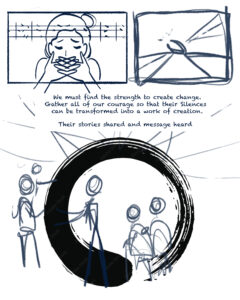
Emily Ehlen: My process started with selecting powerful imagery and phrases in relation to connecting themes found throughout the oral history transcripts. I composed thumbnails with the intent to represent the information clearly and use symbolism to convey the narrative. I wanted to use as much text from the source as I could, but I wanted to avoid it being too word heavy. It was a balancing act of editing the text and imagery to support each other in the composition and narrative. After developing and consolidating the initial drafts I moved on to tighter linework and color concepts. Once the colors were established, I inlaid patterns and handmade textures to add contrast between objects, panels, and the background. The handmade textures were made with ink washes and spray paint. The final step was applying shading and details to enhance the focus of each element while also keeping the flow throughout the entire composition.
Q: How was your work on this project similar or different to your prior art projects?
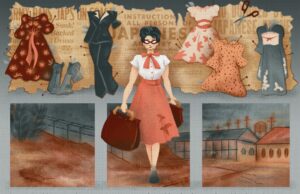
Emily Ehlen: This Japanese American Intergenerational Narratives art project was similar to the comic series Drawn to Art: Tales of Inspiring Women Artists that I worked on in 2021 for the Smithsonian American Art Museum. For that Smithsonian project, I drew a three page comic called “Weaver’s Weaver,” featuring Kay Sekimachi, a Japanese American artist. My process for both projects were pretty identical. Although, I think I had a little more freedom with expanding the storytelling elements working on the JAIN project comics. Overall, they were mutually great experiences that I am so grateful to have been a part of.
Q: How did engaging with the Japanese American Intergenerational Narratives oral history transcripts shape the stories you chose to tell and some of the imagery you used in your graphic art?
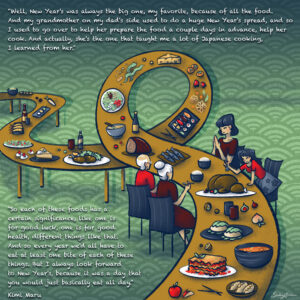
Emily Ehlen: When drafting the concepts of the illustrations, I wanted to use imagery that would convey the message the stories presented. Reading the oral history transcripts, I found lots of interesting details to include, like with the different types of food to include in the FEAST composition. It was inspiring to hear everyone’s unique voice sharing aspects about their and their family’s lives.
Q: How did you choose the various scenes and stories that you eventually depicted? What stories in the transcripts most stood out to you? Why?
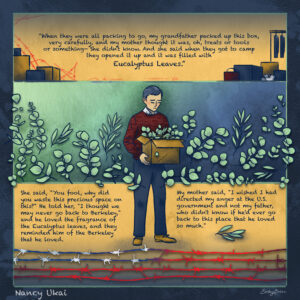
Emily Ehlen: I illustrate with the goal to portray a story the audience can connect and respond to. I wanted to choose stories with lots of emotions that I could highlight in each drawing. The piece I got the most emotional while drawing was Nancy Ukai’s grandfather in EUCALYPTUS. I sympathized with the longing and sadness of missing Berkeley that her grandfather felt. I understood the rationality behind using the box for something else, but that emphasized just how important Berkeley was to him. It was heartbreaking to read, so I knew I had to draw it.
Q: What are some of the story themes that you worked to express throughout your art for this project?
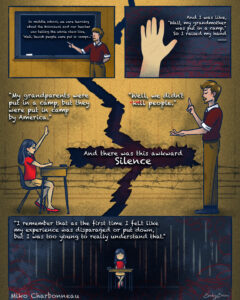
Emily Ehlen: The focus was how the Japanese American incarceration during World War II impacted themselves, their families, and how they responded to it. The themes were identity and belonging, intergenerational connections, and healing. I wanted the weight of the words to be carried through to the art accompanied with them.
Q: Can you describe some of the visual themes or repeated imagery that you incorporated throughout the various pieces you created? How and why did you develop these visual themes?

Emily Ehlen: The color palette I used helped create the tone and atmosphere of each piece separately while also keeping the collection cohesive. The red was used with duality: the bright saturated hue represented youth, rebelliousness, and intensity; while the dark maroon represented authority and repressed quietness. The soft green color was used to depict change and positivity that connects to the healing theme. The navy blue signifies unity and freedom, but it is used with a sense of serenity and heaviness. For example, the blue in TEACHER extrudes an overbearing presence in contrast to when it’s used in TREE. The ochre yellow has different meanings for its surroundings, like in TEACHER it signifies uncertainty, and in STORIES it’s used to display hope.
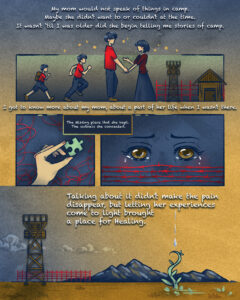
The water pattern, waves, and watercolor texture are used with family elements, and it contrasts the dry gritty spray paint texture that references the environment of Topaz and Manzanar. Waves are symbols of growth, renewal, and transformation. They also represent the unpredictability of life, to which people learn to navigate its ups and downs. The plants and paper cranes also relate to family connections, development, and healing, going through many stages and flourishing together.
For darker imagery, I wanted the red barbed wire to be synonymous with the red stripes we see on the American flag. To show the lack of freedom and injustice that the Japanese Americans faced, those stripes became wire that entrapped and left scars on following generations. The guard towers were a beacon of looming authority and danger at the incarceration camps. They became a mental block for some that were confined in their silences.
Q: While creating the JAIN art, what did you learn that was new to you?
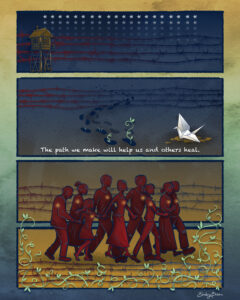
Emily Ehlen: I really enjoyed learning about everyone’s perspectives and experiences with being Japanese American. I am Chinese American, so I empathize with the stories about identity and the sense of belonging. This project lit up my desire to discover more about my culture. My motivation for drawing is to see how my art mirrors my development as a person. I think art is a record of growth and change. Like time, it never stops moving forward.
Q: Can you describe one or two of your favorite pieces that you created for this project? Why does this one stand out for you?
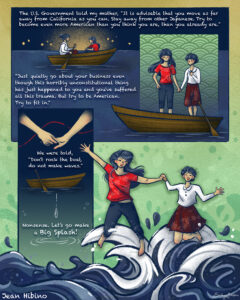
Emily Ehlen: This is like asking the question, “Who’s your favorite child?” It’s super difficult because I love each piece for different reasons. I had the most fun drawing the piece SPLASH, about Jean Hibino and her mother. I think it has the most dynamic composition with how the imagery flows together with the text. I like the sequence of stillness to movement, and how a ripple can start a wave.
Q: What are your hopes for how people engage with your art for this project? Who do you hope sees it? What do you hope people take away from your art for this project?
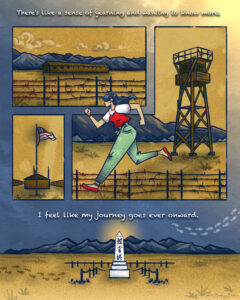
Emily Ehlen: My hope for how people engage with the comic is to have open conversations about them or topics related to it. It would be nice to see what sticks out to people the most and what connections they make through their perspectives. I hope people are able to feel the sentiments in each piece and learn new aspects of its history. I can’t think of anyone specific I’d want to see it, but I strive to be someone who inspires others by taking creative approaches to new ideas. So, I hope other artists who are interested in drawing and story-telling see it
You can see and save copies of larger images of the graphic art that Emily Ehlen created for the Japanese American Intergenerational Narratives Oral History Project in a separate blog post. We encourage you to use and share Emily Ehlen’s artwork, along with the JAIN project oral history interviews, especially in classrooms when teaching the history and legacy of the World War II incarceration of Japanese Americans. When using these images, please credit Emily Ehlen as the artist (for example, Fig. 1, Ehlen, Emily, WAVE, digital art, 2023, Oral History Center, The Bancroft Library, University of California, Berkeley), and see the OHC website for more on permissions when using our oral histories.
Acknowledgments for the Japanese American Intergenerational Narratives Oral History Project
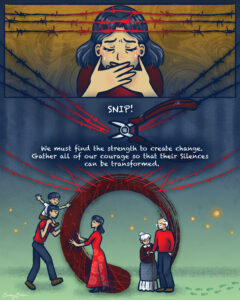
This project was funded, in part, by a grant from the U.S. Department of the Interior, National Park Service, Japanese American Confinement Sites Grant Program. The views and conclusions contained in this document are those of the authors and should not be interpreted as representing the opinions or policies of the U.S. government. Mention of trade names or commercial products does not constitute their endorsement by the U.S. Government.
This material received federal financial assistance for the preservation and interpretation of U.S. confinement sites where Japanese Americans were detained during World War II. Under Title VI of the Civil Rights Act of 1964, Section 504 of the Rehabilitation Act of 1973, and the Age Discrimination Act of 1975, as amended, the U.S. Department of the Interior prohibits discrimination on the basis of race, color, national origin, disability or age in its federally funded assisted projects. If you believe you have been discriminated against in any program, activity, or facility as described above, or if you desire further information, please write to:
Office of Equal Opportunity
National Park Service
1201 Eye Street, NW (2740)
Washington, DC 20005
ABOUT THE ORAL HISTORY CENTER
The Oral History Center of The Bancroft Library preserves voices of people from all walks of life, with varying political perspectives, national origins, and ethnic backgrounds. We are committed to open access and our oral histories and interpretive materials are available online at no cost to scholars and the public. You can find our oral histories from the search feature on our home page. Search by name, keyword, and several other criteria. Sign up for our monthly newsletter featuring think pieces, new releases, podcasts, Q&As, and everything oral history. Access the most recent articles from our home page or go straight to our blog home.
Please consider making a tax-deductible donation to the Oral History Center if you’d like to see more work like this conducted and made freely available online. The Oral History Center is a predominantly self-funded research unit of The Bancroft Library. As such, we must raise the funds to cover the cost of all the work we do, including each oral history. You can give online, or contact us at ohc@berkeley.edu for more information about our funding needs for present and future projects.
Sovetskii Ekran (Soviet Film) Digital Archive at UC Berkeley Library
The Library has purchased the Digital Archive of a Soviet film magazine: Sovetskii Ekran. The archive provides access to the full-text of journal issues that were published from 1925-1998.
Below is the screenshot of the landing page of the Sovietskii Ekran.

At the time of writing this blog, the digitization of issues was completed through 1970 and the additional digitization was in progress.
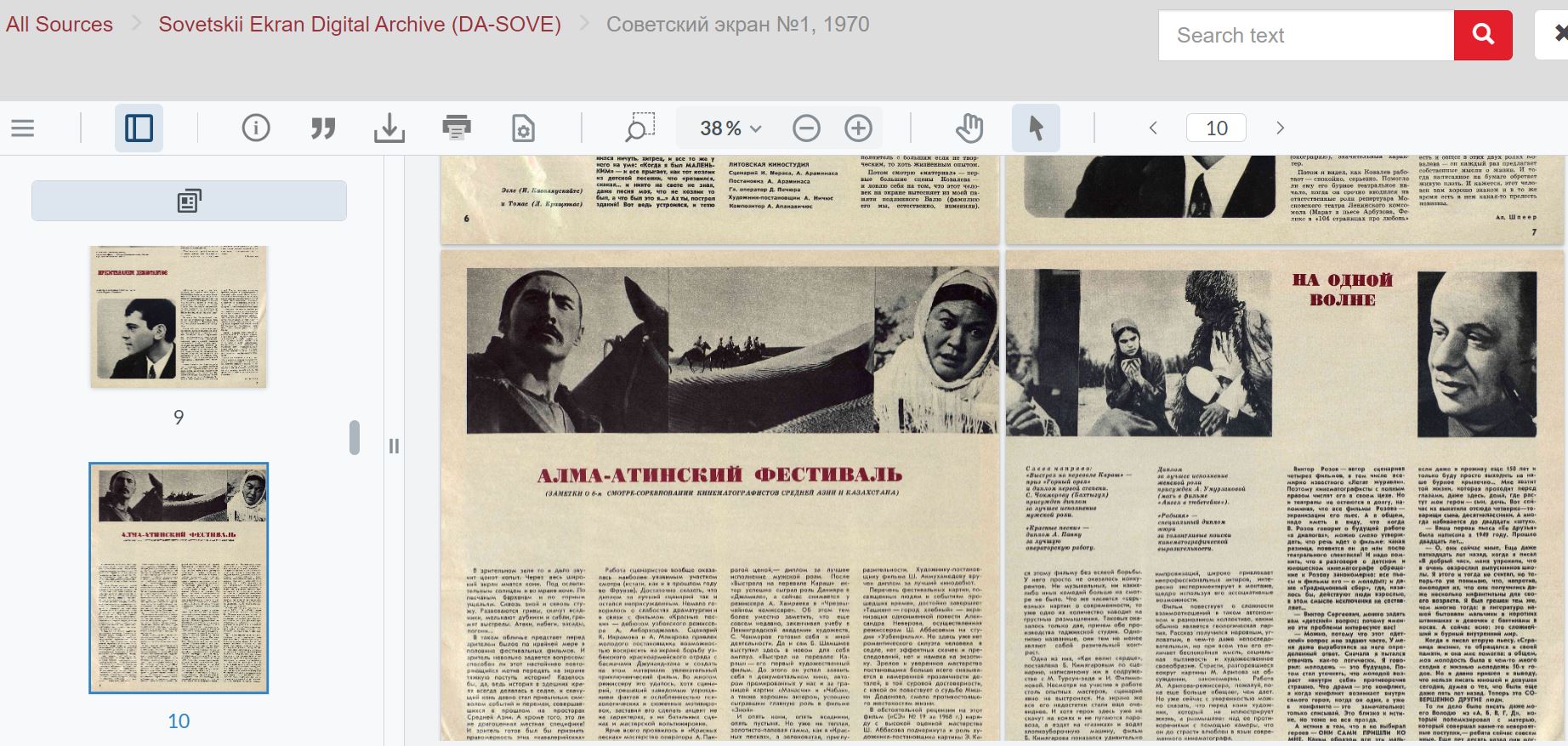
About the journal:
Soviet Screen was a magazine in the USSR that ran from 1925 to 1998 (with a break from 1941 to 1957). It talked about movies, both from the Soviet Union and other countries, cinema history, and had articles critiquing films. They also had reader polls each year to pick the best film, actor, actress, film for children, and music film.
The magazine had different names over the years, like Screen Film Gazeta in 1925, Cinema and Life in 1929–1930, Proletarian Cinema from 1931–1939, and Screen from 1991–1997. Before 1992, it was connected to the Union of Cinematographers of the USSR State Committee for Cinematography and the USSR.
In 1984, they printed 1.9 million copies. In 1991, the editor was Victor Dyomin, and the magazine was published under the title: Screen. It started coming out less often, monthly instead of more frequently. It kept going as Screen Magazine until 1997, then for a few months in 1997-1998, it went back to its old name-Soviet Screen. But it couldn’t survive the financial troubles in 1998 and had to stop publishing (Source: Wikip.).
Native-American Heritage Month

Celebrate National Native American Heritage Month in November with us! We’ve put together a collection of fiction and non-fiction for you to explore. Find more information and discover live events on the Native American Heritage Month website.
Angela Sterritt
Lisa Bird-Wilson
Peter Stark
Rebecca Roanhorse
Stephen Graham Jones
Patty Krawec
PhiloBiblon 2023 n. 6 (octubre): PhiloBiblon White Paper
A requirement of the NEH Foundation grant for PhiloBiblon, “PhiloBiblon: From Siloed Databases to Linked Open Data via Wikibase: Proof of Concept” (PW-277550-21) was the preparation of a White Paper to summarize its results and provide advice and suggestions for other projects that have enthusiastic volunteers but little money:
White Paper
NEH Grant PW-277550-21
October 10, 2023
The proposal for this grant, “PhiloBiblon: From Siloed Databases to Linked Open Data via Wikibase: Proof of Concept,” submitted to NEH under the Humanities Collections and Reference Resources Foundations grant program, set forth the following goals:
This project will explore the use of the FactGrid: database for Historians Wikibase platform to prototype a low-cost light-weight development model for PhiloBiblon:
(1) show how to map PhiloBiblon’s complex data model to Linked Open Data (LD) / Resource Description Framework (RDF) as instantiated in Wikibase;
(2) evaluate the Wikibase data entry module and create prototype query modules based on the FactGrid Query Service;
(3) study Wikibase’s LD access points to and from libraries and archives;
(4) test the Wikibase data export module for JSON-LD, RDF, and XML on PhiloBiblon data,
(5) train PhiloBiblon staff in the use of the platform;
(6) place the resulting software and documentation on GitHub as the basis for a final “White Paper” and follow-on implementation project.
A Wikibase platform would position PhiloBiblon to take advantage of current and future semantic web developments and decrease long-term sustainability costs. Moreover, we hope to demonstrate that this project can serve as a model for low-cost light-weight database development for similar academic projects with limited resources.
PhiloBiblon is a free internet-based bio-bibliographical database of texts written in the various Romance vernaculars of the Iberian Peninsula during the Middle Ages and the early Renaissance. It does not contain the texts themselves; rather it attempts to catalog all their primary sources, both manuscript and printed, the texts they contain, the individuals involved with the production and transmission of those sources and texts, and the libraries holding them, along with relevant secondary references and authority files for persons, places, and institutions.
It is one of the oldest digital humanities projects in existence, and the oldest in the Hispanic world, starting out as an in-house database for the Dictionary of the Old Spanish Language project (DOSL) at the University of Wisconsin, Madison, in 1972, funded by NEH. Its initial purpose was to locate manuscripts and printed texts physically produced before 1501 to provide a corpus of authentic lexicographical material for DOSL. It soon became evident that the database would also be of interest to scholars elsewhere; and a photo-offset edition of computer printout was published in 1975 as the Bibliography of Old Spanish Texts (BOOST). It contained 977 records, each one listing a given text in a given manuscript or printed edition. A second edition followed in 1977 and a third in 1984.
PhiloBiblon was published in 1992 on CD-ROM, incorporating not only the materials in Spanish but also those in Portuguese and Catalan. By this time BOOST had been re-baptized as BETA (Bibliografía Española de Textos Antiguos), while the Portuguese corpus became BITAGAP (Bibliografia de Textos Antigos Galegos e Portugueses) and the Catalan corpus BITECA (Bibliografia de Textos Antics Catalans, Valencians i Balears). PhiloBiblon was ported to the web in 1997; and the web version was substantially re-designed in 2015. PhiloBiblon’s three databases currently hold over 240,000 records.
All of this data has been input manually by dozens of volunteer staff in the U.S., Spain, and Portugal, either by keyboarding or by cutting-and-pasting, thousands of hours of unpaid labor. That unpaid labor has been key to expanding the databases, but just as important, and much more difficult to achieve, has been the effort to keep up with the display and database technology. The initial database management system (DBMS) was FAMULUS running on the Univac 1110 at Madison, a flat-file DBMS originally developed at Berkeley in 1964. In 1985 the database was mapped to SPIRES (Stanford Public Information Retrieval System) and then, in 1987, to a proprietary relational DBMS, Revelation G, running on an IBM PC.
Today we continue to use Revelation Technology’s OpenInsight on Windows, the lineal descendent of Revelation G. We periodically export data from the Windows database in XML format and upload it to a server at Berkeley, where the XTF (eXtensible Text Framework) program suite parses it into individual records, indexes it, and serves it up on the fly in HTML format in response to queries from users around the world. The California Digital Library developed XTF as open source software ca. 2010, but it is now in the process of being phased out and is no longer supported by the UC Berkeley Library.
The need to find a substitute for XTF caused us to rethink our entire approach to the technologies that make PhiloBiblon possible. Major upgrades to the display and DBMS technology, either triggered by technological change or by a desire to enhance web access, have required significant grant support, primarily from NEH, eleven NEH grants from 1989 to 2021. We applied for the current grant in the hope that it would show us how to get off the technology merry-go-round. Instead of seeking major grant support every five to seven years for bespoke technology, this pilot project was designed to demonstrate that we could solve our technology problems for the foreseeable future by moving PhiloBiblon to Wikibase, the technology underlying Wikipedia and Wikidata. Maintained by Wikimedia Deutschland, the software development arm of the Wikimedia Foundation, Wikibase is made available for free. With Wikibase,we would no longer have to raise money to support our software infrastructure.
We have achieved all of the goals of the pilot project under this current grant and placed all of our software development work on GitHub (see below). We received a follow-on two-year implementation grant from NEH and on 1 July 2023 began work to map all of the PhiloBiblon data from the Windows DBMS to FactGrid.
❧ ❧ ❧
For the purposes of this White Paper, I shall focus on the PhiloBiblon pilot project as a model for institutions with limited resources for technology but dedicated volunteer staff. There are thousands of such institutions in the United States alone, in every part of the country, joined in national and regional associations, e.g., the American Association for State and Local History, Association of African American Museums, Popular Culture Association, Asian / Pacific / American Archives Survey Project, Southeastern Museums Conference. Many of their members are small institutions that depend on volunteer staff and could use the PhiloBiblon model to develop light-weight low-cost databases for their own projects. In the San Francisco Bay Area alone, for example there are dozens of such small cultural heritage institutions (e.g., The Beat Museum, GLBT Historical Society Archives, Holocaust Center Library and Archives, Berkeley Architectural History Association.
To begin at the beginning: What is Linked Open Data and why is it important?
What is Wikibase, why use it, and how does it work?
Linked Open Data (LOD) is the defining principle of the semantic web: “globally accessible and linked data on the internet based on the standards of the World Wide Web Consortium (W3C), an open environment where data can be created, connected and consumed on internet scale.”
Why use it? Simply, data has more value if it can be connected to other data, if it does not exist in a silo.
Wikibase in turn is the “free software for open data projects. It connects the knowledge of people and organizations and enables them to open their linked data to the world.” It is one of the backbone technologies of the LOD world.
Why use it? The primary reason to use Wikibase is precisely to make local or specialized knowledge easily available to the rest of the world by taking advantage of LOD, the semantic web. Conversely, the semantic web makes it easier for local institutions to take advantage of LOD.
How does Wikibase work? The Wikibase data model is deceptively simple. Each record has a “fingerprint” consisting of a Label, a Description, and an optional Alias. This fingerprint uniquely identifies the record. It can be repeated in multiple languages, although in every case the Label and the Description in the other languages must also be unique. Following the fingerprint header comes a series of three-part statements (triples, triplestores) that link a (1) subject Q to an (2) object Q by means of a (3) property P. The new record itself is the subject, to which Wikibase assigns automatically a unique Q#. There is no limit, except that of practicality, to the number of statements that a record can contain. They can be input in any order, and new statements are simply appended at the end of the record. No formal ontology is necessary, although having one is certainly useful, as librarians have discovered over the past sixty years. Must records start with a statement of identity, e.g.: Jack Keraouc (Q160534) [is an] Instance of (P31) Human (Q5).[1] Each statement can be qualified with sub-statements and footnoted with references. Because Wikibase is part of the LOD world, each record can be linked to the existing rich world of LOD identifiers: Jack Keraouc (Q160534) in the Union List of Artist Names ID (P245) is ID 500290917.
Another important reason for using Wikibase is the flexibility that it allows in tailoring Q items and P properties to the needs of the individual institution. There is no need to develop an ontology or schema ahead of time; it can be developed on the fly, so to speak. There is no need to establish a hierarchy of subject headings, for example, like that of the Library of Congress as set forth in the Library of Congress Subject Headings (LCSH). LC subject headings can be extended as necessary or entirely ignored. Other kinds of data can also be added:
New P properties to establish categories: nicknames, associates (e.g., other members of a rock band), musical or artistic styles);
New Q items related to the new P properties (e.g., the other members of the band).
There is no need to learn the Resource Description Access (RDA) rules necessary for highly structured data, such as MARC or its eventual replacement, BIBFRAME. This in turn means that data input does not need persons trained in librarianship.
How would adoption of Wikibase to catalog collections, whether of books, archival materials, or physical objects, work in practice? What decisions must be made? The first decision is simply whether (1) to join Wikidata or (2) set up a separate Wikibase instance (like FactGrid).[2] The former is far simpler. It requires no programming experience at all and very little knowledge of data science. Joining Wikidata simply means mapping the institution’s current database to Wikidata through a careful analysis of the database in comparison with Wikidata. For example, a local music history organization, like the SF Music Hall of Fame, might want to organize an archive of significant San Francisco musicians.
The first statement in the record of rock icon Jerry García might be Instance of (P31) Human (Q5); a second statement might be Sex or Gender (P21) Male (Q6581097); and a third, Occupation (P106) Guitarist (Q855091).
Once the institutional database properties have been matched to the corresponding Wikidata properties, the original database must be exported as a CSV (comma separated values) file. Its data must then be compared systematically to Wikidata through a process known as reconciliation, using the open source OpenRefine tool. This same reconciliation process can be used to compare the institutional database to a large number of other LOD services through Mix n Match, which lists hundreds of external databases in fields ranging alphabetically from Art to Video games. Thus the putative SF Music Hall of Fame database might be reconciled against the large Grammy Awards (5700 records) database of the Recording Academy.
Reconciliation is important because it establishes links between records in the institutional database and existing records in the LOD world. If there are no such records, the reconciliation process creates new records that automatically become part of the LOD world.
One issue to consider is that, like Wikipedia, anyone can edit Wikidata. This has both advantages and disadvantages. The advantage is that outside users can correct or expand records created by the institution. The disadvantage is that a malicious user or simply a well-intentioned but poorly informed one can also damage records by the addition of incorrect information.
In the implementation of the new NEH grant (2023-2025), we hope to have it both ways. Our new user interface will allow, let us say, a graduate student looking at a medieval Spanish manuscript in a library in Poland to add information about that manuscript through a template. However, before that information can be integrated into the master database, it would have to be vetted by a PhiloBiblon editorial committee.
The second option, to set up a separate Wikibase instance, is straightforward but not simple. The Wikibase documentation is a good place to start, but it assumes a fair amount of technical expertise. Matt Miller (currently at the Library of Congress) has provided a useful tutorial, Wikibase for Research Infrastructure , explaining how to set up a Wikibase instance and the steps required to go about it. Our programmer, Josep Formentí, has made this more conveniently available on a public GitHub repository, Wikibase Suite on Docker, which installs a standard collection of Wikibase services via Docker Compose V:
Wikibase
Query Service
QuickStatements
OpenRefine
Reconcile Service
The end result is a local Wikibase instance, like the one created by Formentí on a server at UC Berkeley as part of the new PhiloBiblon implementation grant: PhiloBiblon Wikibase instance. He used as his basis the suite of programs at Wikibase Release Pipeline. Formentí has also made available on GitHub his work on the PhiloBiblon user interface mentioned above. This would serve PhiloBiblon as an alternative to the standard Wikibase interface.
Once the local Wikibase instance has been created, it is essentially a tabula rasa. It has no Properties and no Items. The properties would then have to be created manually, based on the structure of the existing database or on Wikidata. By definition, the first property will be P1. Typically it will be “Instance of,” corresponding to Instance of (P31) in Wikidata.
The Digital Scriptorium project, a union catalog of medieval manuscripts in North American libraries now housed at the University of Pennsylvania, went through precisely this process when it mapped 67 data elements to Wikibase properties created specifically for that project. Thus property P1 states the Digital Scriptorium ID number; P2 states the current holding institution, etc.
Once the properties have been created, the next step is to import the data in a batch process, as described above, by reconciling it with existing databases. Miller explains alternative methods of batch uploads using python scripts.
Getting the initial upload of institutional data into Wikidata or a local Wikibase instance is the hard part, but once that initial upload has been accomplished, all data input from then on can be handled by non-technical staff. To facilitate the input of new records, properties can be listed in a spreadsheet in the canonical input order, with the P#, the Label, and a short Description. Most records will start with the P1 property “Institutional ID number” followed by the value of the identification number in the institutional database. The Cradle or Shape Expressions tools, with the list of properties in the right order, can generate a ready-made template for the creation of new records. Again, this is something that an IT specialist would implement during the initial setup of a local Wikibase instance.
New records can be created easily by inputting statements following the canonical order in the list of properties. New properties can also be created if it is found, over time, that relevant data is not being captured. For example, returning to the Jerry García example, it might be useful to specify “rock guitarist”(Q#) as a subclass of “guitarist.”
The institution would then need to decide whether the local Wikibase instance is to be open or closed. If it were entirely open, it would be like Wikidata, making crowd-sourcing possible. If it were closed, only authorized users could add or correct records. PhiloBiblon is exploring a third option for its user interface, crowdsourcing mediated by an editorial committee that would approve additions or changes before they could be added to the database.
One issue remains, searching:
Wikibase has two search modes, one of which is easy to use, and one of which is not.
- The basic search interface is the ubiquitous Google box. As the user types in a request, the potential records show up below it until the user sees and clicks on the requested record. If no match is found, the user can then opt to “Search for pages containing [the search term],” which brings up all the pages in which the search term occurs, although there is no way to sort them. They show up neither in alphabetical order of the Label nor in numerical order of the Q#.
- More precise and targeted searches must make use of the Wikibase Query Service, which opens a “SPARQL endpoint,” a window in which users can program queries using the SPARQL query language. SPARQL pronounced “sparkle,” is a recursive acronym for “SPARQL Protocol And RDF Query Language,” designed by and for the World Wide Web Consortium (WC3) as the standard language for LOD triplestores, just as SQL (Structured Query Language) is the standard language for relational database tables.
SPARQL is not for the casual user. It requires some knowledge of SPARQL or similar query languages as well as of the specifics of Wikibase items and properties. Many Wikibase installations offer “canned” SPARQL queries. In Wikidata, for example, one can use a canned query to find all of the pictures of the Dutch artist Jan Vermeer and plot their current locations on a map, with images of the pictures themselves. In fact, Wikidata offers over 400 examples of canned queries, each of which can then serve as a model for further queries.
How, then, to make more sophisticated searches available for those who do not wish to learn SPARQL?
For PhiloBiblon we are developing masks or templates to facilitate searching for, e.g., persons, institutions, works. Thus, the institutions mask allows for searches for free text, the institution, its location, its type (e.g., university), and subject headings:
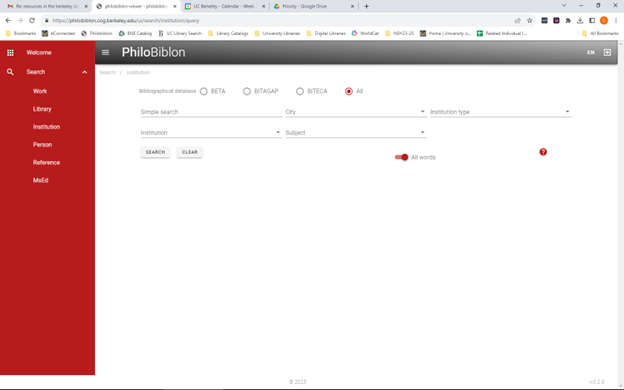
This mimics the search structure of the PhiloBiblon legacy website:
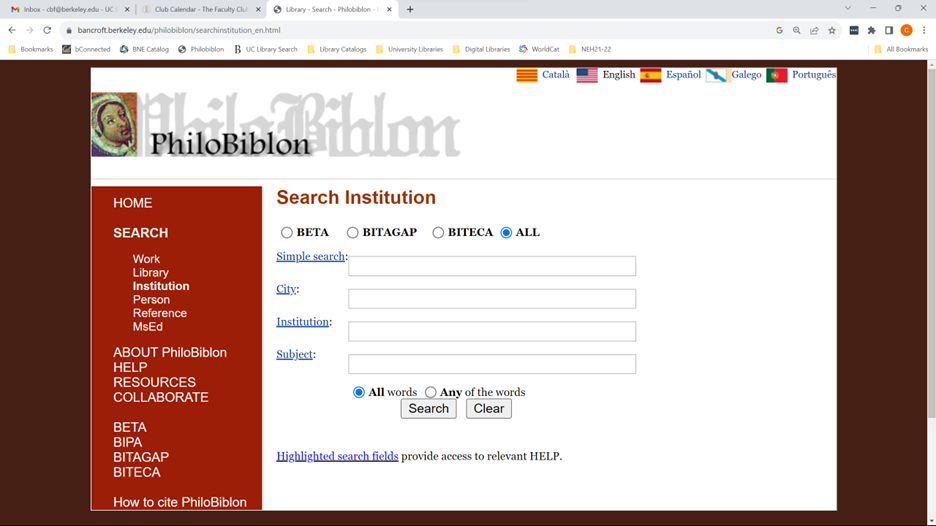
The use of templates does not, however, address the problem of searching across different types of objects or of providing different kinds of outputs. For example, one could not use such a template to plot the locations and dates of Franciscans active in Spain between 1450 and 1500. For this one needs a query language, i.e., SPARQL.
We have just begun to consider this problem under the new NEH implementation grant. It might be possible to use a Large Language Model query service such as ChatGPT or Bard as an interface to SPARQL. A user might send a prompt like this: “Write a SPARQL query for FactGrid to find all Franciscans active in Spain between 1450 and 1500 and plot their locations and dates on a map and a timeline.” This would automatically invoke the SPARQL query service and return the results to the user in the requested format.
Other questions and considerations will undoubtedly arise for any institution or project contemplating the use of Wikibase for its database needs. Nevertheless, we believe that we have demonstrated that this NEH-funded project can serve as a model for low-cost light-weight database development for small institutions or similar academic projects with limited resources.
Questions may be addressed to Charles Faulhaber (cbf@berkeley.edu).
[1] For the sake of convenience, I use the Wikidata Q# and P# numbers.
[2] For a balanced discussion of whether to join Wikidata or set up a local Wikibase instance, see Lozana Rossenova, Paul Duchesne, and Ina Blümel, “Wikidata and Wikibase as complementary research data management services for cultural heritage data.” The 3rd Wikidata Workshop, Workshop for the scientific Wikidata community, @ ISWC 2022, 24 October 2022. CEUR_WS, vol-3262.
Charles Faulhaber
University of California, Berkeley
Halloween Picks 2023

Celebrate this year’s Spooky Season with some of these terrifying and suspenseful titles below. From ghosts to haunted houses and even our own thoughts, check out these books if you’re feeling the Halloween festivities this October.
Silvia Moreno-Garcia
Clay McLeod Chapman
Gretchen Felker-Martin
Ana Reyes
Ainslie Hogarth
Stephen King
Indigenous Peoples’ Day

Celebrate Indigenous Peoples’ Day this Monday, October 9th with these wonderful selections by Native authors illustrating stories on Native history and fiction.
Michelle Good
Louise Erdrich
S. C. Gwynne
Leslie Marmon Silko
Tommy Orange
Louise Erdrich
Townsend Berkeley Books Chat with Margaretta Lovell
Painting the Inhabited Landscape: Fitz H. Lane and the Global Reach of Antebellum America
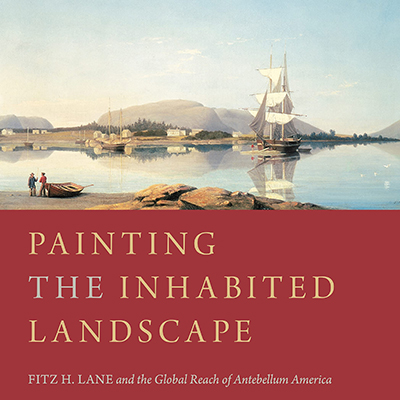
The impulse in much nineteenth-century American painting and culture was to describe nature as a wilderness on which the young nation might freely inscribe its future: the United States as a virgin land, unploughed, unfenced, and unpainted. Insofar as it exhibited evidence of a past, its traces pointed to a geologic or cosmic past, not a human one.
The work of the New England artist Fitz H. Lane, however, was decidedly different. In Painting the Inhabited Landscape (Penn State, 2023), Margaretta Lovell (History of Art) singles out the modestly scaled, explicitly inhabited landscapes of Fitz H. Lane and investigates the patrons who supported his career, with an eye to understanding how New Englanders thought about their land, their economy, their history, and their links with widely disparate global communities.
Lane’s works depict nature as productive and allied in partnership with humans to create a sustainable, balanced political economy. What emerges from this close look at Lane’s New England is a picture not of a “virgin wilderness” but of a land deeply resonant with its former uses — and a human history that incorporates, rather than excludes, Native Americans as shapers of land and as agents in that history.
Calling attention to unexplored dimensions of nineteenth-century painting, Painting the Inhabited Landscape is a major intervention in the scholarship on American art of the period, examining how that body of work commented on American culture and informs our understanding of canon formation.
Lovell is joined by David Henkin (History). After a brief discussion, they respond to questions from the audience.
Resources: Oxford Research Encyclopedias
Through an arrangement with the California Digital Library and Oxford University Press, the Library has access to the entire collection of Oxford Research Encyclopedias. Oxford University Press works with international communities of scholars to develop comprehensive collections of in-depth summaries on a growing range of topics for the Oxford Research Encyclopedia (ORE). Articles are peer-reviewed and vetted by editorial boards of leading international scholars and researchers, and content is added and updated monthly and optimized for discoverability. Each ORE contains links to citations and related resources, creating a hub for deeper inquiry.
The topics include:
African History
American History
Anthropology
Asian History
Business and Management
Climate Science
Communication
Criminology and Criminal Justice
Economics and Finance
Education
Encyclopedia of Social Work
Environmental Science
Global Public Health
International Studies
Latin American History
Linguistics
Literature
Natural Hazard Science
Neuroscience
Oxford Classical Dictionary
Planetary Science
Politics
Psychology
Religion
